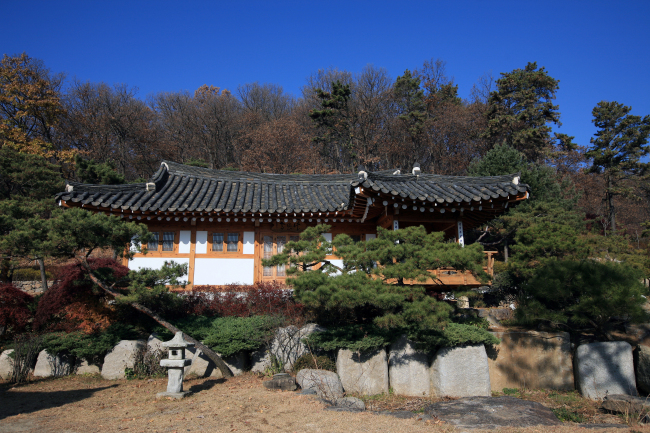Winter is the low season for travel in Korea. Day temperatures remain below freezing and snowfalls cause traffic jams, often paralyzing major cities.
But it’s one of the best times of the year to enjoy the scenic winter views in the provinces. “Hanok” lodgings across the country offer true relaxation for those who wish to get away from the crowds at ski resorts or hot springs and look back on the year.
The Korea Tourism Organization has recently recommended top hanok accommodation for winter travelers.
Ssangsanjae in Gurye
Ssangsanjae, nestled between Jirisan Mountain and the Seomgjingang River, is thought to be the spot where Doseon Guksa, a Korean Buddhist monk, formulated the principles of Korean feng shui. Located in Sansa Village, South Jeolla Province, Ssangsanjae has been the main family house of the Oh clan for about 200 years. The hanok lodging is composed of separate buildings that were used as a kitchen, guestroom, study room and more on the 16,500-square-meter estate. For more information, call (061) 782-5179.
Cheongsong Hanok Village
The hanok village in Cheongsong, North Gyeongsang Province, has no televisions in its guestrooms. Instead, guests are invited to play traditional folk games in the courtyard, take a stroll through the scenic village or read books in rooms with traditional “ondol” floor heating systems. For more information, call (054) 870-6240.
Yeongwol Jogyeondang and Ugujeong Hanok
The Jogyeondang and Ugujeong hanoks in Yeongwol, registered as cultural assets of Gangwon Province, have quite different styles. Jogyeongdang, owned by one of the Kim clans, combines old and new. The guesthouse has been renovated to offer modern amenities. It holds programs for visitors, including storytelling by the oldest woman in the family and a tea ceremony. Ugujeong Hanok is a well-preserved set of hanok. Composed of three types of houses, it offers visitors a taste of the cozy, rural life of Korea. For more information, call 1577-0545.
But it’s one of the best times of the year to enjoy the scenic winter views in the provinces. “Hanok” lodgings across the country offer true relaxation for those who wish to get away from the crowds at ski resorts or hot springs and look back on the year.
The Korea Tourism Organization has recently recommended top hanok accommodation for winter travelers.
Ssangsanjae in Gurye
Ssangsanjae, nestled between Jirisan Mountain and the Seomgjingang River, is thought to be the spot where Doseon Guksa, a Korean Buddhist monk, formulated the principles of Korean feng shui. Located in Sansa Village, South Jeolla Province, Ssangsanjae has been the main family house of the Oh clan for about 200 years. The hanok lodging is composed of separate buildings that were used as a kitchen, guestroom, study room and more on the 16,500-square-meter estate. For more information, call (061) 782-5179.
Cheongsong Hanok Village
The hanok village in Cheongsong, North Gyeongsang Province, has no televisions in its guestrooms. Instead, guests are invited to play traditional folk games in the courtyard, take a stroll through the scenic village or read books in rooms with traditional “ondol” floor heating systems. For more information, call (054) 870-6240.
Yeongwol Jogyeondang and Ugujeong Hanok
The Jogyeondang and Ugujeong hanoks in Yeongwol, registered as cultural assets of Gangwon Province, have quite different styles. Jogyeongdang, owned by one of the Kim clans, combines old and new. The guesthouse has been renovated to offer modern amenities. It holds programs for visitors, including storytelling by the oldest woman in the family and a tea ceremony. Ugujeong Hanok is a well-preserved set of hanok. Composed of three types of houses, it offers visitors a taste of the cozy, rural life of Korea. For more information, call 1577-0545.

Royal residence of Joseon
Found on the grounds of Sungkyunkwan University in Seoul and originally the residence of Joseon-era royalty, this hanok was moved to the northern city of Yeoncheon, Gyeonggi Province. After being restored, it began accommodating tourists.
The hanok was built in the 1800s and once belonged to Lee Geun, grandson of King Gojong of the late Joseon era. It was restored with natural materials to promote a traditional Korean lifestyle. The hanok also overlooks Yeoncheon rice field.
The hanok is close to natural attractions including Jusangjeolli Cliff, near where the Imjingang and Hantangang rivers meet. The Jeonggok Prehistoric Museum offers a glimpse into the lives of prehistoric Koreans.
For more information, call (031) 834-8383.
By Lee Woo-young (wylee@heraldcorp.com)







![[KH Explains] Hyundai's full hybrid edge to pay off amid slow transition to pure EVs](http://res.heraldm.com/phpwas/restmb_idxmake.php?idx=644&simg=/content/image/2024/04/18/20240418050645_0.jpg&u=20240419100350)






![[From the Scene] Monks, Buddhists hail return of remains of Buddhas](http://res.heraldm.com/phpwas/restmb_idxmake.php?idx=652&simg=/content/image/2024/04/19/20240419050617_0.jpg&u=20240419175937)

![[KH Explains] Hyundai's full hybrid edge to pay off amid slow transition to pure EVs](http://res.heraldm.com/phpwas/restmb_idxmake.php?idx=652&simg=/content/image/2024/04/18/20240418050645_0.jpg&u=20240419100350)

![[Today’s K-pop] Illit drops debut single remix](http://res.heraldm.com/phpwas/restmb_idxmake.php?idx=642&simg=/content/image/2024/04/19/20240419050612_0.jpg&u=)